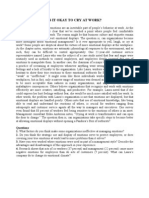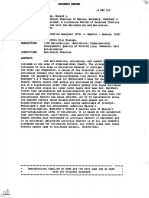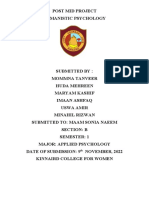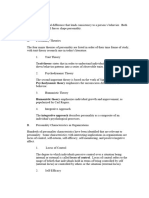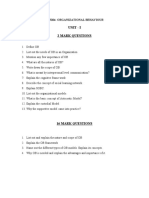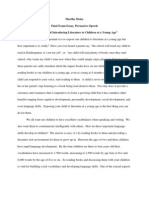Personality, Perception, and Attribution: Chapter Scan
Personality, Perception, and Attribution: Chapter Scan
Uploaded by
Satria Akbar WicaksanaCopyright:
Available Formats
Personality, Perception, and Attribution: Chapter Scan
Personality, Perception, and Attribution: Chapter Scan
Uploaded by
Satria Akbar WicaksanaOriginal Description:
Original Title
Copyright
Available Formats
Share this document
Did you find this document useful?
Is this content inappropriate?
Copyright:
Available Formats
Personality, Perception, and Attribution: Chapter Scan
Personality, Perception, and Attribution: Chapter Scan
Uploaded by
Satria Akbar WicaksanaCopyright:
Available Formats
32 Chapter 3: Personality, Perception, and Attribution
PERSONALITY, PERCEPTION, AND ATTRIBUTION
CHAPTER SCAN
This chapter begins a two-chapter approach examining individual differences. Much of this
chapter is related to interactional psychology, and the advances made regarding personality
and behavior in specific situations. Personality characteristics discussed are locus of control,
self-esteem, self-efficacy, self-monitoring, and positive/negative affect. Personality theories
explained are trait theory, psychodynamic theory, humanistic theory, and the integrative
approach. The chapter also examines how social perceptions influence the way we view the
world, and how attributions influence how we assign causality for behaviors.
LEARNING OBJECTIVES
After reading this chapter, you should be able to do the following:
1.
2.
3.
4.
5.
6.
7.
8.
9.
Describe individual differences and their importance in understanding behavior.
Define personality.
Explain four theories of personality.
Identify several personality characteristics and their influences on behavior in
organizations.
Explain how personality is measured.
Discuss Carl Jungs contribution to our understanding of individual differences, and
explain how his theory is used in the Myers-Briggs Type Indicator.
Define social perception and explain how characteristics of the perceiver, the target, and
the situation affect it.
Identify five common barriers to social perception.
Explain the attribution process and how attributions affect managerial behavior.
33 Chapter 3: Personality, Perception, and Attribution
KEY TERMS
The following key terms are introduced in Chapter 3:
individual differences
interactional psychology
personality
trait theory
psychodynamic theory
humanistic theory
integrative approach
locus of control
self-esteem
self-monitoring
positive affect
negative affect
strong situation
projective test
behavioral measures
self-report questionnaire
Myers-Briggs Type Indicator (MBTI)
extraversion
Introversion
sensing
intuiting
thinking
feeling
judging
perceiving
social perception
discounting principle
selective perception
stereotype
first-impression error
implicit personality theory
self-fulfilling prophecy
impression management
attribution theory
fundamental attribution error
self-serving bias
THE CHAPTER SUMMARIZED
I.
THINKING AHEAD: The Woman (Oprah) Behind the Company (Harpo)
II.
INDIVIDUAL DIFFERENCES AND ORGANIZATIONAL BEHAVIOR
This chapter explores the differences of individuals in skills, abilities, personalities,
perceptions, attitudes, values, and ethics.
In order to understand individuals in organizations, the approach of interactional psychology
is useful. This approach emphasizes understanding the person and the situations in order to
understand human behavior.
III.
PERSONALITY
Personality is an individual difference that lends consistency to a persons behavior. The
variables influencing behavior include heredity, personality, perception, attribution, attitudes,
values, and ethics.
A.
Personality Theories
The four major theories of personality are listed in order of their time frame of study,
with trait theory research rare in today's literature.
1.
Trait Theory
Chapter 3: Personality, Perception, and Attribution
34
Trait theory states that in order to understand individuals, we must break
down behavior patterns into a series of observable traits.
2.
Psychodynamic Theory
The second important theory is based on the work of Sigmund Freud.
Psychodynamic theory emphasizes the unconscious determinants of behavior.
3.
Humanistic Theory
Humanistic theory emphasizes individual growth and improvement, as
popularized by Carl Rogers.
4.
Integrative Approach
The Integrative approach describes personality as a composite of an
individual's psychological processes.
B.
Personality Characteristics in Organizations
Hundreds of personality characteristics have been identified that are relevant to
personality. Some characteristics with interesting implications in organizations are:
locus of control, self-esteem, self-efficacy, self-monitoring, and positive/negative
affect.
1.
Locus of Control
The degree to which individuals perceive control over a situation being internal
or external is called locus of control. Locus of control compares the range of
beliefs that individuals hold in terms of being controlled by self (internal locus)
or controlled by others or the situation (external locus).
2.
Self-Esteem
An individual's self-worth is referred to as self-esteem. Individuals with high
self esteem have positive feelings about themselves. Low self-esteem
individuals are strongly affected by what others think of them, and view
themselves negatively.
3.
Self-Monitoring
The extent to which people base their behavior on cues from other people and
situations is self-monitoring. Individuals high in self-monitoring pay attention
to what behavior is appropriate in certain situations by watching others and
behaving accordingly. Low self-monitoring individuals prefer that their
35 Chapter 3: Personality, Perception, and Attribution
behavior reflect their attitudes, and are not as flexible in adapting their behavior
to situational cues.
4.
Positive/Negative Affect
Individuals exhibit attitudes about situations in a positive or negative fashion.
An individual's tendency to accentuate the positive aspects of situations is
referred to as positive affect, while those accentuating less optimistic views
are referred to as having negative affect. Employees with positive affect are
absent from work less often. Negative affect individuals report a higher level of
job stress.
C.
Measuring Personality
There are a host of methods that can be used to measure and assess personality. The
most popular are projective tests, behavioral measures, and self-report questionnaires.
IV.
A POPULAR APPLICATION OF PERSONALITY THEORY IN
ORGANIZATIONS: THE MYERS-BRIGGS TYPE INDICATOR
Carl Jung developed the Jungian theory of individual differences. The MBTI is an instrument
to measure this theory. Jung suggested that human similarities and differences could be
understood by combining performance. People are not exclusively one way or another, there
is a preference for extraversion or introversion, just as there is for right or left handedness.
Chapter 3: Personality, Perception, and Attribution
36
A.
The Preferences
The combination of the four basic preferences indicate a persons psychological type.
1.
Extraversion/Introversion
Extroverts are energized by interactions with others while introverts prefer
time alone.
2.
Sensing/Intuiting
Sensors gather information through the five senses. Intuitors gather
information through a sixth sense.
3.
Thinking/Feeling
Thinkers make logical, objective decisions. Feelers make decisions in a more
personal way.
4.
Judging/Perceiving
Judgers have a preference for closure and organization in their life while
perceivers are more spontaneous and try to keep their options open.
B.
The Sixteen Types
The four preferences can be combined to form sixteen psychological types. Types are
not inherently good or bad. Each has its own strengths and weaknesses.
V.
SOCIAL PERCEPTION
Social perception is the way we view the world around us. It is the process of interpreting
information about other people, a process heavily used by management.
A.
Characteristics of the Perceiver
Three characteristics of a perceiver define one's perception of another person.
Familiarity with the person being perceived leads the perceiver to believe that he or she
understands the intentions of the individual. The second characteristic is the mood we
as a perceiver may be in when we interact with someone else. Positive moods equate
with positive impressions of others. The perceiver's self-concept leads us to a more
negative or positive view of the attributes of the individual.
B.
Characteristics of the Target
Through a combination of physical appearance, verbal and nonverbal communication,
and apparent intentions, the person being perceived influences the social perception
process.
C.
Characteristics of the Situation
37 Chapter 3: Personality, Perception, and Attribution
The social context in which you meet an individual has a great deal to do with
perceiving the individual positively or negatively. The strength of the situational cues
also affects person perception. Strong situational cues lead us to assume that a
person's behavior is prompted by the situation rather than his/her own personality.
D.
Barriers to Social Perception
There are five distinct barriers to social perception, which are: selective perception,
stereotyping, first-impression error, implicit personality theories, and self-fulfilling
prophecies.
Selective perception is the process of selecting information that supports our
individual viewpoints while discounting information that threatens our viewpoints.
This approach leads to verbal rationalizations. When we stereotype an individual we
are not allowing his or her individual strengths to be relevant to our perception,
because we have generalized about the individual. First impression error is the
tendency to form lasting opinions about an individual based on the initial meeting or
perception. This is a major difficulty with hiring from interviews, where the first
impression lasts into the socialization process. Finally, implicit personality theory
clouds our judgment of perception by extrapolating our mini-theories of others'
behavior to opinions about specific individuals. We may project an outcome by our
expectations. This is referred to as a self-fulfilling prophecy.
E.
Impression Management
The conscious monitoring and manipulation of others' opinions is referred to as
impression management.
VI.
ATTRIBUTION IN ORGANIZATIONS
As humans, we are naturally curious about the causes of our behavior and the behavior of
others. The process of assigning causality to behavior is attribution.
A.
Internal and External Attributions
Organizational attributes which can be attributed to a specific internal or external source of
control.
B.
Attributional Biases
There are two common errors that affect the attribution process: self-serving bias, and
the fundamental attribution error. The fundamental attribution error is the
tendency to make attributions to internal causes when focusing on someone else's
behavior. Self-serving bias is the tendency to attribute one's own successes to
internal causes and one's failures to external causes.
Chapter 3: Personality, Perception, and Attribution
38
VII.
MANAGERIAL IMPLICATIONS: USING PERSONALITY, PERCEPTION, AND
ATTRIBUTION AT WORK
VIII.
LOOKING BACK: Oprah's Reflections on Management
CHAPTER SUMMARY
Individual differences are factors that make individuals unique. They include personalities,
perceptions, skills and abilities, attitudes, values, and ethics.
The trait theory, psychodynamic theory, humanistic theory, and integrative approach are all
personality theories.
Managers should understand personality because of its effects on behavior. Several
characteristics affect behavior in organizations, including locus of control, self-esteem,
self-monitoring, and positive/negative affect.
Personality has a stronger influence in weak situations, where there are fewer cues to
guide behavior.
One useful framework for understanding individual differences is type theory, developed
by Carl Jung and measured by the Myers-Briggs Type Indicator (MBTI).
Social perception is the process of interpreting information about another person. It is
influenced by characteristics of the perceiver, the target, and the situation.
Barriers to social perception include selective perception, stereotyping, first-impression
error, implicit personality theories, and self-fulfilling prophecies.
Impression management techniques such as name-dropping, managing one's appearance,
self-descriptions, flattery, favors, and agreement are used by individuals to control others'
impressions of them.
Attribution is the process of determining the cause of behavior. It is used extensively by
managers, especially in evaluating performance.
39 Chapter 3: Personality, Perception, and Attribution
REVIEW QUESTIONS: SUGGESTED ANSWERS
1. What are individual differences, and why should managers understand them?
In order to understand human behavior, we must know something about the person and about
the situation. Since no two individuals are alike, managers face the challenge of working with
people who possess a multitude of individual characteristics. Important individual differences
include personality characteristics, social perceptions and attributions of causality. The more a
manager understands these differences, the better he or she can work with others.
2. Define personality, and describe its origins.
Personality is a relatively stable set of characteristics that influences an individual's behavior.
Family influences, cultural influences, educational influences, and environmental forces all
shape personality.
3. Describe four theories of personality and what each contributes to our knowledge of
personality.
The four theories of personality are trait theory, psychodynamic theory, humanistic theory, and
the integrative theory. Trait theory was the earliest approach toward studying personality, and
in part because of criticism of its approach, it supported the basis for other types of theories.
Psychodynamic theory is based on the work of Freud, emphasizing the unconscious
determinants of behavior. Humanistic theory emphasizes individual growth. The integrative
approach is the most comprehensive because it includes a variety of psychological processes.
4. Describe the eight preferences of the Myers-Briggs Type Indicator. How does this
instrument measure Carl Jung's ideas?
Jung's theory of individual differences is put into application through the Myers-Briggs
instrument. The initial division he proposed was extroverted and introverted individuals. He
added the measurement of sensing and intuiting, which depict how individuals gather
information. The third set includes thinking and feeling, which are styles of decision-making.
The fourth set reflects one's orientation to the outer world.
5. What factors influence social perception? What are the barriers to social perception?
Perception is influenced by all things with which we come into contact, to understand our
surroundings and ourselves. Selective perception is the tendency to choose information that
supports our viewpoints. Stereotyping is a generalization made about a group of people, and
is often inaccurate. First impression error is the tendency to form lasting opinions about an
individual based on initial perceptions. Implicit personality theories are mini-theories applied
to simplify our understanding of another person. Self-fulfilling prophecies are expectations
that become reality.
6. Describe the errors that affect the attribution process.
40
Chapter 3: Personality, Perception, and Attribution
The fundamental attribution error is the tendency to make attributions to internal causes when
focusing on someone else's behavior. Self-serving bias is the tendency to attribute one's own
successes to internal causes and one's failure to external causes.
DISCUSSION AND COMMUNICATION QUESTIONS: SUGGESTED ANSWERS
1. What contributions can high self-monitors make in organizations? Low self-monitors?
High self-monitors would be good in sales jobs or in any position that requires meeting the
public because of their attentiveness to cues from other people and from situations. Low selfmonitors would be good in jobs that are consistent with their fundamental beliefs. Because
they prefer that their behavior be consistent with their attitudes, they would be uncomfortable
in certain sales situations, such as having to sell a product they didn't believe in.
2. How can managers improve their perceptual skills?
Managers need to be aware of characteristics in themselves, in situations, and in other people
that affect social perception. They need to understand the barriers to accurate perception and
guard against these barriers.
3. Which has the strongest impact on personality: heredity or environment?
This is a good discussion question in class, particularly if there are psychology and sociology
students taking the organizational behavior course. There are good arguments for either
position. Both have an impact.
4. How can managers make more accurate attributions?
By gathering information carefully and possessing an awareness of self-serving bias and the
fundamental attribution error, managers can make more accurate attributions.
5. How can managers encourage self-efficacy in employees?
Managers can provide job challenges, coaching and counseling for improved performance, and
rewarding employees' achievements to enhance self-efficacy.
41 Chapter 3: Personality, Perception, and Attribution
6. How can self-serving bias and the fundamental attribution error be avoided?
Awareness is the first step. Careful information gathering and conscious attention to one's own
attributional tendencies are essential. Owning up to one's failures is important.
7. You have been asked to develop a training program for interviewers. An integral part of this
training program focuses on helping interviewers develop better social perception skills. Write
an outline for this section of the training program. Be sure to address barriers to social
perception and ways to avoid these barriers.
During class discussion, encourage students to share interview experiences they have had in which
misperceptions played a role. This would also be a good assignment to refer back to during the
discussion of learning in Chapter 6.
8. Form groups of four to six, then split each group in half. Debate the origins of personality,
with one half taking the position that personality is inherited, and the other half taking the
position that personality is formed by the environment. Each half should also discuss the
implications of its position for managers.
To enhance the debate, this assignment could be made prior to the class in which the debate will
occur so that students have the opportunity to conduct outside research on the different
perspectives.
ETHICS QUESTIONS: SUGGESTED ANSWERS
1. What are the ethical uses of personality tests? What are the unethical uses?
Hiring, firing, or promoting someone on the basis of a personality test is not only unethical, it
is illegal. Students may have interesting examples of tests that they have heard have been
administered. Personality tests should be used to enhance one's understanding of self and
others.
2. Suppose a manager makes an incorrect attribution for an employee's poor performance
(for instance, the manager cites equipment failure), and peers know the employee is at fault.
Should they blow the whistle on their colleague?
The preferable way to approach the situation is through problem reporting, either with the
supervisor or an established outlet in the organization. (Whistle-blowing typically refers to
going outside the organization.) Perhaps the co-workers should try to assist the employee
before reporting him or her.
Chapter 3: Personality, Perception, and Attribution
42
3. Suppose one of your colleagues wants to eliminate all biases and stereotypes from the
hiring process. He suggests that only resumes be used, with no names or other identifying
dataonly experience and education. What are the ethical consequences of this approach?
Would any group be unfairly disadvantaged by this approach?
It might be admirable and a decent gesture to approach equality in this fashion, but it is also
naive. Although the interviewing technique is flawed with first impression biases and selection
biases, it is also a way to ascertain the fit between the position and the individual.
Additionally, it could be prejudicial against those that do not have the experience or education
for positions that do not require these qualifications.
4. Suppose a manager makes a misattribution of an employee's poor performance. What are
the ethical consequences of this?
This could be sexist, racist, homophobic, or elitist. If we stereotype individuals with attribution
we are unethical.
CHALLENGES
3.1
ARE YOU A HIGH OR LOW SELF-MONITOR?
Students should complete this challenge prior to class discussion on self-monitoring so that their
responses will not be biased. During class discussion, students can be asked how their selfmonitoring tendency might influence their performance on the job.
EXPERIENTIAL EXERCISES
3.1 MBTI TYPES AND MANAGEMENT STYLES
This exercise illustrates David Keirsey's temperaments and their related management styles.
Students should complete the MBTI prior to the exercise. Most university counseling centers
can administer the MBTI and provide individual results for students.
To do the exercise, students should be assigned to groups according to their temperament:
NF, NT, SJ, or SP. The rather vague task students are assigned is intended to bring out the
different management styles of the various temperaments. The exercise works best when
students are not aware of their MBTI types.
Instructors who are unfamiliar with the MBTI may wish to have someone who has completed
the MBTI certification training help debrief the students at the end of the exercise.
To complete the exercise, do the following:
1. Have students complete the MBTI. Score the questionnaires if the short version is used.
2. Assign students to groups based on their temperaments.
3. Have students complete the group task.
4. Ask each group to report to the class.
5. As each group reports, reveal its temperament and management style, using the information
that follows.
43 Chapter 3: Personality, Perception, and Attribution
6. Hand out individual MBTI profiles and discuss them.
MBTI TEMPERAMENTS AND LEADERSHIP STYLES
NF -- NFs are catalysts. Their focus is on individuals within the organization and on
individual growth. They use a very participative style and are often referred to as charismatic.
NFs are verbally fluent and are superb at giving feedback. They are good listeners and
talented at managing interpersonal transactions. They see the possibilities in people and can
often turn liabilities into assets. NFs are likely to become worn out and overextended by their
focus on relationships. They have a high need for approval and may seem to others to be too
anxious to please. They need positive feedback and despise impersonal treatment. They value
harmony and cooperation.
NT -- NTs are visionaries. Their focus is on designing systems and the organization's
mission. They believe the organization must grow and develop, and they place a strong
emphasis on competence and intelligence. They expect a lot of themselves and of others. NTs
welcome change, and focus on possibilities. They can easily see the long-range implications
for the organization. They tend to be on the cutting edge of things and may be
nonconformists. They are the portrait painters of ideas and encourage ideas in their
employees. They also enjoy solving problems. NTs love the creative process, but once it is
finished they prefer to let someone else take over to run the system. They value competence
and achievement, and they may ignore the feelings of others unknowingly.
SJ -- SJs are traditionalists. Their focus is on the organization and its hierarchy, and they are
masters at defining policies, rules, and procedures. As managers, they are patient, thorough,
steady, and reliable. They value caution and accuracy in work. SJs preserve the traditions in
life and have a keen sense of social responsibility. They are loyal and industrious but may be
irritated when others do not play by their rules. They are decisive and are happiest when they
can plan their work and work their plan. SJs run efficient meetings and want colleagues to get
to the point and stick to it. They can become impatient when projects are delayed and prefer
sensible, stable, reliable colleagues.
SP -- SPs are troubleshooters. They are good at putting out fires and solving problems.
They are very realistic, and to them everything is negotiable. They display an open, flexible
style and focus on the present time. SPs like change and are very adaptable. They dislike
being told how to do things and may become impatient with bureaucracy. If there are no fires
to put out, SPs may make mischief. They do not enjoy maintaining the status quo but want to
be where the action is. SPs listen to their superiors but may not do what they are told. They
are flexible and open-minded in relations with others, and they are easy to get along with.
They may appear hard to predict because of their flexibility.
To learn more about management styles, we suggest the following:
D. Keirsey and M. Bates, Please Understand Me (Prometheus Nemesis, Del Mar, CA: 1978).
R. Benfara, and J. Knox, Understanding Your Management Style (Lexington, Mass.:
Lexington Books, 1991).
O. Kroeger and J. Thuesen, Type Talk at Work (New York: Delacorte Press, 1992).
3.2 STEREOTYPES IN EMPLOYMENT INTERVIEWS
Instructor's Notes:
44
Chapter 3: Personality, Perception, and Attribution
The following exercise illustrates the influence of stereotypes on employment interviews.
Students are given a transcript of an interview in which the candidate is applying for a job as a
laborer. The transcript reflects a number of characteristics of the interviewee that are consistent
with the negative stereotype of African-Americans (the applicant is poor, has a criminal record,
and is behind on child support payments). The transcript also presents several items of
information inconsistent with the stereotype (the applicant is Catholic, drives a pickup truck, and
likes hockey games). Further, information is presented that is not stereotypical (the applicant
watches television comedies, is from a small town, and is applying for a blue-collar job).
One-half of the students should be handed a version of the transcript that states that the job
candidate is white. The other half of the students should be handed the version of the transcript
that states that the job candidate is African-American. The transcript should be collected after five
minutes. One week (or at least several days) later, ask students to write down all they remember
about the job candidates. Students who read about an African-American will be more likely to
recall the stereotypical African-American characteristics.
Students are asked to review the transcript that records an applicant's interview for a job as a
laborer. They are asked to memorize as much of the interview as possible. They are then asked to
write down everything they can remember about the job candidate. As you photocopy the
following interview transcript, include version 1 of the introduction with half the copies and
version 2 with the other half.
Discussion Questions:
1. In what ways does the exercise show that stereotypes can influence interviewers, even without
their awareness?
2. Many people believe stereotypes are motivated by hate or insecurity. How do these exercise
results fit this idea?
3. What can be done to reduce the effects of stereotypes in interviews?
4. If stereotypes help you remember information that is consistent with the stereotype and help
you ignore information that is inconsistent with the stereotype, how can stereotypes be changed?
INTRODUCTION:
Mr. Harris is a twenty-seven year old African-American male. He is applying for a job working on
a loading dock. Mr. Harris is interviewing as part of a social services program.
INTERVIEW TRANSCRIPT
(I = interviewer; A = applicant)
I: Please tell me a little bit about your last job.
A: Well, the job was basically a blue-collar job. I worked in a factory doing janitor work mostly.
Second shift for most of the time. I didn't mind the job too much. I've been out of work for quite
a while now. I guess you could say I was at the poverty level for the last year.
I: Do you have a criminal record?
45 Chapter 3: Personality, Perception, and Attribution
A: Well, yeah, but the crime wasn't too serious. I spent a few weeks in jail for breaking and
entering when I was a kid. Me and some friends broke into a department store. Pretty stupid.
I: Tell me a little bit about your education, Mr. Harris.
A: I finished high school in 1980. I was brought up in a Catholic family in a small southern
country town. So I went to a Catholic school. Kind of unusual I guess. I used to really give the
nuns a hard time (laughs). I was thinkin' about going to college but never made it.
I: Have you and your family adjusted well to moving into the area?
A: Yeah, I like New Jersey. I don't live with my wife no....er, a ...any more. I hope to see my
three kids pretty soon. Maybe bring them up here. Haven't seen 'em for years. I really need the
job because I'm behind on my child support.
I: What have you been doing in your spare time?
A: Well, I been looking around the area quite a bit. I've been drivin' my truck, you know just
checkin' things out. I went to a hockey game the other night. Had a good time. Otherwise I
watch a little TV. Watch a lot of comedies.
I: Please tell me about your accomplishments.
A: Well, I was a sort of a star athlete in school. Our team went to the state tournament. I
suppose I could have been a college player. Besides that, I won a writing contest when I was in
high school. It was for the region. Oh yeah, I got a commendation from my last job. They
wanted me to train the new guys.
I: What are your greatest weaknesses?
A: I could probably take orders better. But I don't get too upset. Maybe I should read a little
more. 'Been a long time since school.
INTRODUCTION:
Mr. Harris is a twenty-seven year old white male. He is applying for a job working on a loading
dock. Mr. Harris is interviewing as part of a social services program.
INTERVIEW TRANSCRIPT
(I = interviewer; A = applicant)
I: Please tell me a little bit about your last job.
A: Well, the job was basically a blue-collar job. I worked in a factory doing janitor work mostly.
Second shift for most of the time. I didn't mind the job too much. I've been out of work for quite
a while now. I guess you could say I was at the poverty level for the last year.
I: Do you have a criminal record?
A: Well, yeah, but the crime wasn't too serious. I spent a few weeks in jail for breaking and
entering when I was a kid. Me and some friends broke into a department store. Pretty stupid.
I: Tell me a little bit about your education, Mr. Harris.
46
Chapter 3: Personality, Perception, and Attribution
A: I finished high school in 1980. I was brought up in a Catholic family in a small southern
country town. So I went to a Catholic school. Kind of unusual I guess. I used to really give the
nuns a hard time (laughs). I was thinkin' about going to college but never made it.
I: Have you and your family adjusted well to moving into the area?
A: Yeah, I like New Jersey. I don't live with my wife no....er, a ...any more. I hope to see my
three kids pretty soon. Maybe bring them up here. Haven't seen 'em for years. I really need the
job because I'm behind on my child support.
I: What have you been doing in your spare time?
A: Well, I been looking around the area quite a bit. I've been drivin' my truck, you know just
checkin' things out. I went to a hockey game the other night. Had a good time. Otherwise I
watch a little TV. Watch a lot of comedies.
I: Please tell me about your accomplishments.
A: Well, I was a sort of a star athlete in school. Our team went to the state tournament. I
suppose I could have been a college player. Besides that, I won a writing contest when I was in
high school. It was for the region. Oh yeah, I got a commendation from my last job. They
wanted me to train the new guys.
I: What are your greatest weaknesses?
A: I could probably take orders better. But I don't get too upset. Maybe I should read a little
more. 'Been a long time since school.
47 Chapter 3: Personality, Perception, and Attribution
The MBTI - What it is!
The Myers-Briggs Type Indicator (MBTI) is a self-reporting, nonjudgmental (does not assign
a "good" or "bad" connotation) psychological instrument. It is designed to sort people
according to their preferences in four areas: where people get their energy (internally or
externally), how people perceive their surroundings (detailed or intuitive), the basis of their
decision making (logic or value driven), and the lifestyle used to deal with their environment
(judging or perceiving).
The MBTI is based on Carl Jung's research. Dr. Jung believed that an individual's behavior
reflects a pattern that indicates a person's preference for their energy source, data collection,
and decision making. Isabel Briggs Myers and Katherine Briggs developed the MBTI
instrument based on Jung's work, personal observation, and extensive research. The
developers added a dimension to Jung's theory that deals with a person's lifestyle choices.
Using an analogy is the best way to define the concept of preference. We sort people into left
and right handedess. Most of us clearly show a preference for the use of one hand over the
other. In the process we develop the skills, strengths, and abilities of one hand and
underdevelop the other. We still use both hands, hence one becomes dominant and the other
becomes auxiliary. People develop their personalities in the same manner. You are born with
certain traits, and if your environment supports that development, you will have a welldeveloped dominant trait, and most likely, a less-well-developed auxiliary trait. In addition
you will have other parts of your personality that receive very little attention. These traits
surface occasionally; usually when a situation exists that puts our dominant and auxiliary traits
at a disadvantage. For example, when something happens that really upsets us, our initial
response is usually much different than our "normal" way of doing things.
The self-reporting and self-validating done via the MBTI sorts people on the four areas. The
first area is extraversion or introversion. The person who indicates a preference for
extraversion is one whose energy is directed outward and prefers to interact with people and
things. A person who indicates a preference for introversion is one whose energy is directed
inward and prefers concepts and ideas. In the former case, a person "speaks before he/she
thinks" and in the latter case, a person "thinks before he/she speaks."
The second area that the MBTI addresses is that of perceiving or data collection (sensing or
intuition). Those people who indicate a preference for sensing rely on actual data and pay
attention to details. Those folks who indicate a preference for intuition rely on inspiration and
look at the "big picture."
The third area addresses the decision making process that people use. Those people who
prefer thinking base their decision on logic and principles. On the other hand, those who
prefer feeling base their decisions on human values and harmonious relationships.
The final area that the MBTI addresses is that of lifestyle. Here people indicate their preferred
and most often used mental preference (perceiving or judging). Those who prefer judgment
indicate that decisiveness and task or project completion are important. Those who prefer
perception indicate that curiosity and starting a task or project is of value.
Chapter 3: Personality, Perception, and Attribution
48
What benefits do the students get from using the MBTI? The MBTI results are individually
affirming, eye-opening, barrier-breaking, and communication-enhancing. The emphasis is
always on the strength of the preference and the fact that differences in people are strengths
not weaknesses. Arguably the biggest single benefit is that the results of the MBTI affirm that
we are all unique and that each of us has a gift to offer. It helps people understand themselves
and those with whom they come in contact. Additionally, because the MBTI does not put
people in a "box," people have a better understanding of the basis for certain behaviors and a
healthy appreciation for the uniqueness that each person offers.
To administer the MBTI you need to be a "qualified user." Two methods exist: taking the
correct tests and measurements graduate course, or participating in a qualifying workshop.
Most universities have certified personnel in the testing department who can assist you with
testing. If you wish to become a qualified user, two of the companies that offer training are:
Type Resources, Inc
101 Chesnut Street #135
Gaithersburg, MD 20877
(301) 963-1283
Dr. Hartzler, owner and senior instructor for Type Resources, wrote her dissertation
concerning the MBTI. She has extensive publications addressing the practical aspects and
applications of the MBTI.
Otto Kroeger Associates
3605 Chain Bridge Road #C
Fairfax, VA 22030
(703) 591-6284
Mr Kroeger is the co-author of Type Talk and Type Talk at Work. He is currently working on
an additional book dealing with type and relationships.
We highly recommend that the instructor and all assistants take the MBTI and receive
qualified feedback. We've placed a series of MBTI-related exercises in strategic points
throughout the instructor's manual to show the versatility and depth of the information gained
through the use of the MBTI. We've developed the experiential exercises to significantly
enhance the material in the following chapters: Communication, Leadership, Motivation,
Decision Making, Conflict Resolution, Power, Stress and Time Management, and Managing
Change.
Although each exercise can stand alone, we suggest that the MBTI exercises be used in
conjunction with at least one challenge from the text. The MBTI gives students insightful
clues on the behaviors of others--it helps to answer the question "why did they act that way?"
We believe that it is highly beneficial to explore the conceptual material through reading,
lecturing, and practicing and then to offer a possible explanation of the behavioral parameters
that influenced those results. We suggest therefore that the MBTI exercises be used after
you've conducted an exercise that reinforces and highlights the concept you are teaching.
Exercise Format
49 Chapter 3: Personality, Perception, and Attribution
The MBTI exercises are constructed using a format and descriptors that may be unfamiliar to
some management or organizational behavior faculty. Here's a brief explanation of the format
and unfamiliar descriptors:
Exercise Learning Objectives:
Traditional meaning applies. These objectives form the basis for the exercise and provide the
central point for any modifications you feel are necessary.
Exercise Overview:
A "quick review" of the exercise. This section should give you a flavor of what will happen
and how it will happen. Additionally, it gives the instructor an idea of the core competency
required to use the exercise.
Exercise Description:
Here we have the step-by-step instructions. We recommend that the instructor read all of
them before proceeding. In some cases, these instructions may be too detailed and in others,
not detailed enough. We've tried to hit the "happy medium" so that the instructor has
sufficient knowledge to conduct the exercise but does not feel constrained to "follow the
yellow brick road."
What the instructor should expect:
We've provided a capsule version of the expected outcomes. Please use this as a frame of
reference. Although no two groups will have exactly the same outcome, the instructor should
see a definite similarity between the on-going exercise and these brief descriptions. The
instructor wrap-up is based somewhat on the expected outcomes and how close or how far
off-the-mark this particular class was. Over time, each instructor will most likely see slightly
different outcomes. We encourage you to record that data for future reference.
Instructor's Summary:
Based on the expected outcomes, this section provides a mini-summary of the lesson. We're
giving you, the instructor, a guide on which to base your final remarks. We do not expect you
to read this; but rather to use it to help you focus your thoughts and ideas. We believe that
even if the exercise goes "bust" you can accomplish your learning objectives with a solid
wrap-up.
Report Out:
Reporting out is a process used to have the students verbally state the results of their exercise.
Generally, these mini-summaries demonstrate the learning that has occurred. During the
reporting out process and after the students are finished, we recommend that the instructor
highlight key areas and show the similarities and differences between groups. We've found
50
Chapter 3: Personality, Perception, and Attribution
that the instructor actively summarizing in this fashion helps the students retain the
information as well as providing fuel for the final summary.
Observers:
The role of the observer (student or instructor) is to watch the interaction that occurs in the
group. The observer should be looking for such things as non-verbal actions, tone, pitch, rate,
word choice, stress points, and the like. In those instances where a student observer is used,
we recommend that the student observer give feedback to the group first, and to the class
second. Generally, it takes about 5 minutes for the group feedback as well as 3 minutes for
each observer to give feedback to the entire class. Time permitting, we encourage the
instructor to have all observers report to the class. However, in those instances where the
time remaining is insufficient, the instructor should call on one or two observers to report out
and then wrap-up the exercise.
References
For personal study, we suggest that you read the following books:
Gifts Differing, I.B. Myers with P. B. Myers, Consulting Psychologists Press
Portraits of Temperament and Please Understand Me, D. Keirsey, Prometheus Nemesis
Books
Type Talk and Type Talk at Work, O. Kroeger, Delcorte Press
Psychological Types, C.G. Jung, Princeton University Press
Applications of Myers-Briggs Type Indicator in Higher Education, J. A. Provost, Consulting
Psychologists Press
51 Chapter 3: Personality, Perception, and Attribution
ALTERNATIVE EXPERIENTIAL EXERCISE
IDENTIFYING COGNITIVE STYLES
Instructor's Notes:
This exercise adapts the cognitive styles to situations that require students to identify and
define. This exercise is probably better as homework to be discussed in class after completion.
Each method of handling the crisis is perfectly valid. Point out to students there is no "best"
cognitive style. Each is valuable in organizations. The cognitive styles in the exercise are as
follows: Mona is NF; Denise is NT; Bill is ST, and Blake is SF.
IDENTIFYING COGNITIVE STYLES
Adapted from O. Kroeger and J. M. Thuesen, Type Talk at Work, New York:
Delacorte Press, 1992, 165-166.
Assume that it is Friday at 3:00 p.m. A customer calls to say that a major shipment of
computers you sent a week ago has not arrived, and that they must have the computer by
noon Monday. Failing to deliver the computers will result in losing the client. The manager
must either find the shipment, or reship the computers and make sure they arrive on time.
Below are descriptions of how four different managers would react to this crisis. Read their
reactions, and answer the questions that follow.
BILL accepts the reality that the shipment of computers is lost and that he shouldn't waste
time tracking it down. He sees no alternative but to put together a new shipment and send it
out immediately. He expects all his workers to pitch in and stay late to get the new shipment
out.
MONA considers the possibility that the original shipment might be recovered, as this would
save everyone the trouble of having to prepare a new shipment. She attempts to motivate a
team of workers to work together to track down the shipment. At the same time, she puts
together another team to work out a backup plan. She works back and forth between the two
teams, trying to inconvenience everyone as little as possible.
DENISE tries to track down the original shipment because no matter what happens it will
have to be located. She sees putting together another shipment as the only reliable solution.
At the same time, she is going to develop a strategy for evaluating shipping operations to
ensure that this problem doesn't come up again.
BLAKE writes off the original shipment and feels in reality there's no time to waste looking
for it. He polls his workers to see who can work late to put together a new shipment, and if
no one volunteers, he will do it himself.
ANSWER THE FOLLOWING:
1. Bill's cognitive style is _____________________.
What clues were evident in his handling of the crisis?
52
Chapter 3: Personality, Perception, and Attribution
2. Mona's cognitive style is ____________________.
What clues were evident in her handling of the crisis?
3. Denise's cognitive style is _____________________.
What clues were evident in her handling of the crisis?
4. Blake's cognitive style is _____________________.
What clues were evident in his handling of the crisis?
EXTRA EXPERIENTIAL EXERCISES
The following alternative exercises to supplement the material in the textbook can be obtained
from:
Marcic, Dorothy & Seltzer, Joe Organizational Behavior: Experiences and Cases, 5th Ed.
South Western College Publishing Company, 1998.
Interpersonal Perception Exercise. p. 43-45. Time: 30 minutes.
Purpose: To compare your perception of yourself with others perceptions of you.
Attribution Theory: A Case of Personality?. p. 46-49. Time: 50 minutes or more.
Purpose: To examine interpersonal perception issues and apply the attribution theory.
Fandt, Patricia M. Management Skills: Practice and Experience. West Publishing Company,
1994.
In-Basket Exercise 2: Listening to Others. p. 15-16.
In-Basket Exercise 4: Eliciting Ideas, Feelings, and Perceptions from Others. p. 19-20.
ROLE PLAYS
Additional role plays relevant to the material in this chapter are located in Appendix A of this
instructors manual.
You might also like
- 1.1.3 - Motivations and Responses - Student 24100% (1)1.1.3 - Motivations and Responses - Student 2414 pages
- Study On The Adoption of Food Safety Rules On Street Food Vendors in Imphal East and Imphal West of ManipurNo ratings yetStudy On The Adoption of Food Safety Rules On Street Food Vendors in Imphal East and Imphal West of Manipur6 pages
- HRM: People Manager Coursera Milestone Week 4No ratings yetHRM: People Manager Coursera Milestone Week 45 pages
- All India Central Council of Trade UnionsNo ratings yetAll India Central Council of Trade Unions3 pages
- Human Resource Management: Selection MethodsNo ratings yetHuman Resource Management: Selection Methods27 pages
- Impact of HR Technology Solution in Retail ManagementNo ratings yetImpact of HR Technology Solution in Retail Management6 pages
- A Study of Spiritual Intelligence Among Post Graduate StudentsNo ratings yetA Study of Spiritual Intelligence Among Post Graduate Students7 pages
- Occupational Stress and Job Satisfaction Among College Teachers in PuneNo ratings yetOccupational Stress and Job Satisfaction Among College Teachers in Pune42 pages
- Human Resource Management: Acme Widget CompanyNo ratings yetHuman Resource Management: Acme Widget Company16 pages
- Job Analysis Questionnaire Job Analysis QuestionnaireNo ratings yetJob Analysis Questionnaire Job Analysis Questionnaire5 pages
- Answer-Sheet OF Standard Progressive Matrices Sets A, B. C, D, & E0% (1)Answer-Sheet OF Standard Progressive Matrices Sets A, B. C, D, & E2 pages
- Individual & Group Dynamics - DCP - SyllabusNo ratings yetIndividual & Group Dynamics - DCP - Syllabus6 pages
- Herzberg's Two-Factor Theory of MotivationNo ratings yetHerzberg's Two-Factor Theory of Motivation2 pages
- The Relationship Between Emotional Intelligence and SelfEfficacy Within The Higher Education PopulationNo ratings yetThe Relationship Between Emotional Intelligence and SelfEfficacy Within The Higher Education Population15 pages
- SAIL JO Manual 2022 - General Functional ManagementNo ratings yetSAIL JO Manual 2022 - General Functional Management162 pages
- Forces Affecting Organizational BehaviorNo ratings yetForces Affecting Organizational Behavior1 page
- Indian Academy of Applied Psychology (Regd.) : Membership FormNo ratings yetIndian Academy of Applied Psychology (Regd.) : Membership Form1 page
- Personality, Perception, and Attribution: Chapter ScanNo ratings yetPersonality, Perception, and Attribution: Chapter Scan25 pages
- Human Goals Humanistic Perspective: Introd UctionNo ratings yetHuman Goals Humanistic Perspective: Introd Uction17 pages
- Unit - I 2 Mark Questions: Ba9204-Organizational Behaviour60% (5)Unit - I 2 Mark Questions: Ba9204-Organizational Behaviour6 pages
- Psychological Well-Being at Work MeasuresNo ratings yetPsychological Well-Being at Work Measures20 pages
- Spinoza's Ethics: Freedom and Determinism: SSRN Electronic Journal February 2012No ratings yetSpinoza's Ethics: Freedom and Determinism: SSRN Electronic Journal February 201211 pages
- 2330-Excerpt From Remembrance of Things Past by Marcel ProustNo ratings yet2330-Excerpt From Remembrance of Things Past by Marcel Proust4 pages
- Study On The Adoption of Food Safety Rules On Street Food Vendors in Imphal East and Imphal West of ManipurStudy On The Adoption of Food Safety Rules On Street Food Vendors in Imphal East and Imphal West of Manipur
- Impact of HR Technology Solution in Retail ManagementImpact of HR Technology Solution in Retail Management
- A Study of Spiritual Intelligence Among Post Graduate StudentsA Study of Spiritual Intelligence Among Post Graduate Students
- Occupational Stress and Job Satisfaction Among College Teachers in PuneOccupational Stress and Job Satisfaction Among College Teachers in Pune
- Job Analysis Questionnaire Job Analysis QuestionnaireJob Analysis Questionnaire Job Analysis Questionnaire
- Answer-Sheet OF Standard Progressive Matrices Sets A, B. C, D, & EAnswer-Sheet OF Standard Progressive Matrices Sets A, B. C, D, & E
- The Relationship Between Emotional Intelligence and SelfEfficacy Within The Higher Education PopulationThe Relationship Between Emotional Intelligence and SelfEfficacy Within The Higher Education Population
- SAIL JO Manual 2022 - General Functional ManagementSAIL JO Manual 2022 - General Functional Management
- Indian Academy of Applied Psychology (Regd.) : Membership FormIndian Academy of Applied Psychology (Regd.) : Membership Form
- Personality, Perception, and Attribution: Chapter ScanPersonality, Perception, and Attribution: Chapter Scan
- Unit - I 2 Mark Questions: Ba9204-Organizational BehaviourUnit - I 2 Mark Questions: Ba9204-Organizational Behaviour
- Spinoza's Ethics: Freedom and Determinism: SSRN Electronic Journal February 2012Spinoza's Ethics: Freedom and Determinism: SSRN Electronic Journal February 2012
- 2330-Excerpt From Remembrance of Things Past by Marcel Proust2330-Excerpt From Remembrance of Things Past by Marcel Proust












